How to clean and organise your fridge
Curate, clean and re-think your fridge to make it more practical, inspiring and sustainable
How to organise: fridge cleaning hacks
Spring-cleaning the house, de-cluttering your wardrobe and curating the bookshelves… what's next?
Perhaps it's lockdown boredom, heightened germ paranoia or the incessant stress snacking, but focus has shifted onto the refrigerator. Instagram's burgeoning trend for #fridgegoals and #fridgeporn is a rainbow of bright, aspirational images proving that organised fridges are the height of cool. Certainly if you spend as much time as we do with our heads in the fridge, pondering the next nibble, it makes sense to create a pleasant space.
But the appeal of an inviting fridge goes well beyond aesthetics. Re-thinking your food storage system helps you eat sustainably by making produce last longer and reducing reliance on plastic packaging. And showcasing bright, healthy produce will shape your eating habits for the better, by making you more inclined to graze on fresh ingredients or prepare something from scratch instead of reaching for a bag of Kettle Chips.
The deep clean
Start from scratch and use this as opportunity to audit the forgotten jars lurking on the top shelf and target those sticky stains.
1. Take everything out of the fridge. Check expiration dates and inspect jams and sauces for the first fuzz of mould. Throw away anything that is past its best.
2. Fill the sink with warm water and two tablespoons of baking soda; food can absorb odours so avoid any scented or chemical cleaners inside the fridge. Wipe down sticky jars, bottles or pots that will be going back into the fridge. Set aside to fully dry.
3. Now that the fridge is empty, take out the salad drawers and any removable shelves. Soak and wash in the baking soda and water then leave to dry.
4. Use a damp cloth to wipe around the inside of the empty fridge and pat down with kitchen paper or dry cloth to ensure the interior is dry. Use an old toothbrush to scrub corners and hard-to-reach bits.
5. Wipe down the outside door and handle with soapy water or an antibacterial spray, before returning food to the fridge using the organisation method below.
The organisation
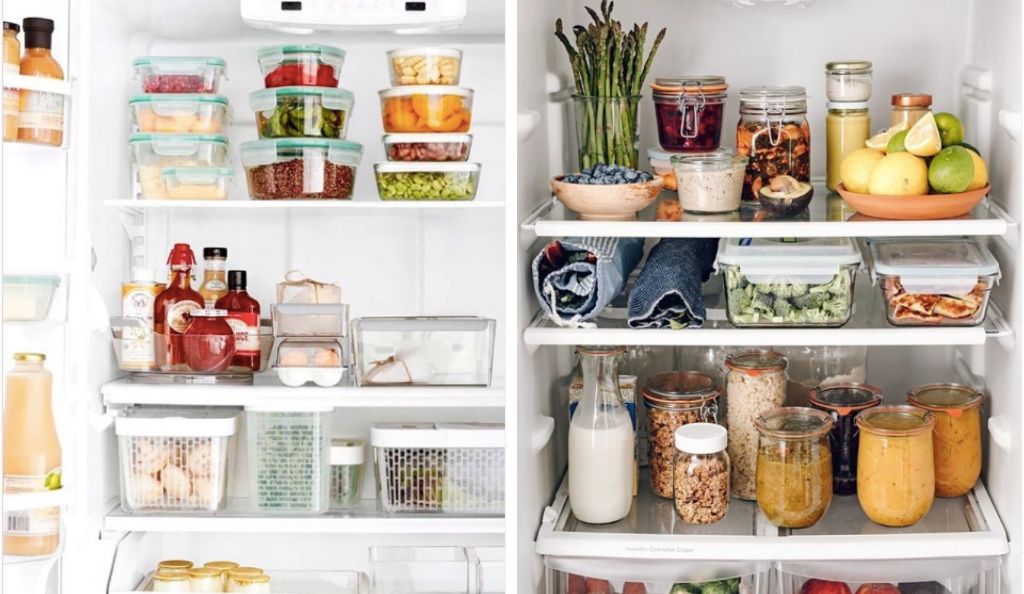
Do you keep condiments in the fridge? Should butter be in a dish in the pantry or wrapped in a chilled fridge? What about chocolate – cold or room temperature? While there are plenty of personal preferences that play into your fridge organisation system, these are the general rules to optimise food safety and preservation.
Avoid overfilling your fridge: not only does it increase the likelihood of having to throw food away before you have a chance to eat it, but it can also interfere with the air circulation and alter the temperature equilibrium. As you use things and put them back, try to keep produce that needs eating soonest towards the front of the fridge to reduce waste.
Inside door
This is the warmest part of the fridge and the most prone to temperature fluctuations when you open the door, so keep longer-life items such as jams, spreads, juices and sauces here.
Upper shelves
This is where to store foods that do not need cooking, such as leftovers, cured meats and ready meals.
Middle shelves
The constant temparature makes this the best place to keep all dairy items, from milk and yoghurt to cheese and butter.
Bottom shelf
This is the coldest part of the fridge so the best place for storing raw meat and fish. It also reduces the risk of juices dripping down and contaminating other items.
Drawers
The drawers are more humid, so ideal for keeping fruit, vegetables, herbs and salad fresh.
The storage
Airtight glass containers are the gold standard of the organised fridge. While BPA chemicals in plastic can contaminate food, glass is totally safe. Microwave-ready and easy to clean, it seals in freshness and prevents odours. Plus, being able to see the contents saves time rummaging around and prevents forgotten leftovers from mouldering away under foil.
Group items logically – with a container of cheeses, one of different dips, one for leftovers. Where possible, remove and recycle packaging, then wash any fruit or vegetables before storing so everything is ready to eat and free of any germs or pesticides.
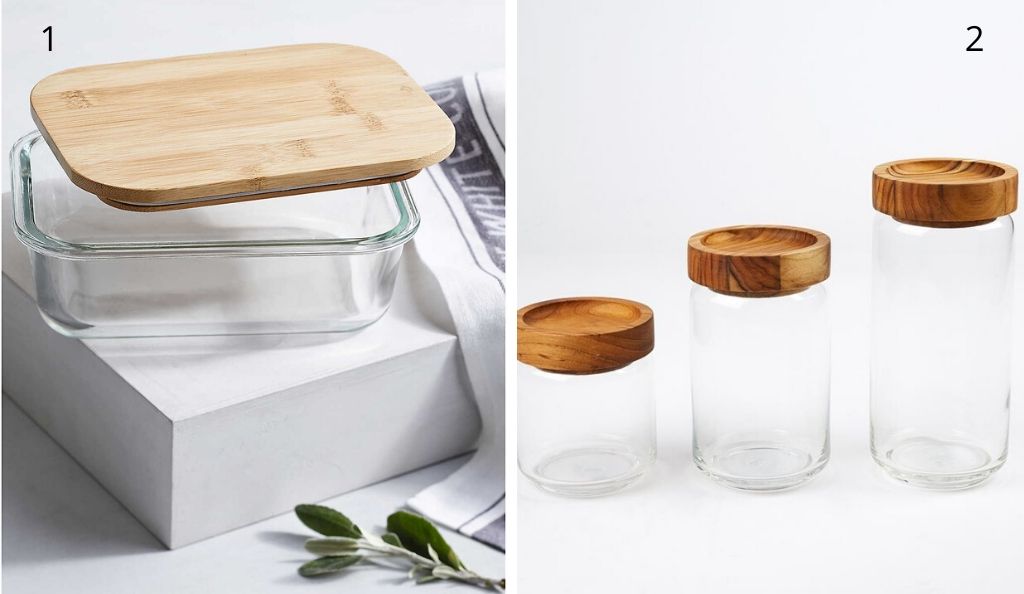
1. Medium Glass Storage Box, £14 – buy here. 2. Teak Stacking Storage Jar, £25 – buy here.
Avoid single-use clingfilm and foil and keep things fresh with more sustainable options. These patterned beeswax wraps provide a watertight seal and a gorgeous pop of colour. Reusable mesh bags are a great way to keep loose vegetables together and bring some order to the bottom drawer of the fridge. Take the bags with you to the greengrocer or supermarket to avoid plastic bags, then transfer straight to the fridge.
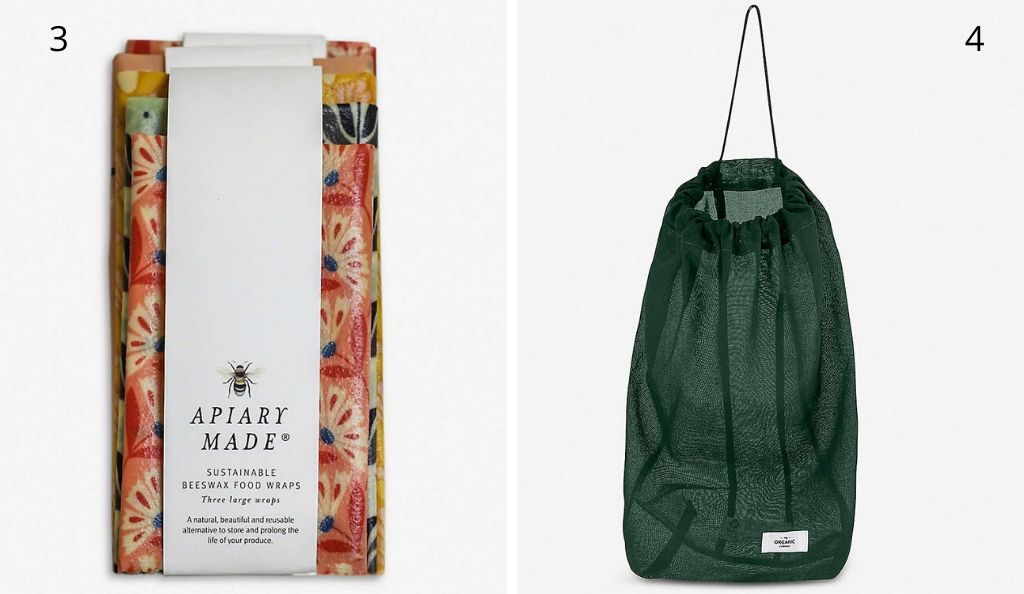
3. Three Large Sustainable Beeswax Food Wraps, £26 – buy here. 4. Organic Cotton Food Bag, £8 – buy here.
Those of you not lucky enough to have a dedicated wine fridge will be familiar with the Tetris-like attempts of stacking bottles into a fridge and the inevitable frustration when they roll around and squash nearby food. Maximise space with these ingenious and almost invisible stacking systems, allowing you to double- or triple-stack.
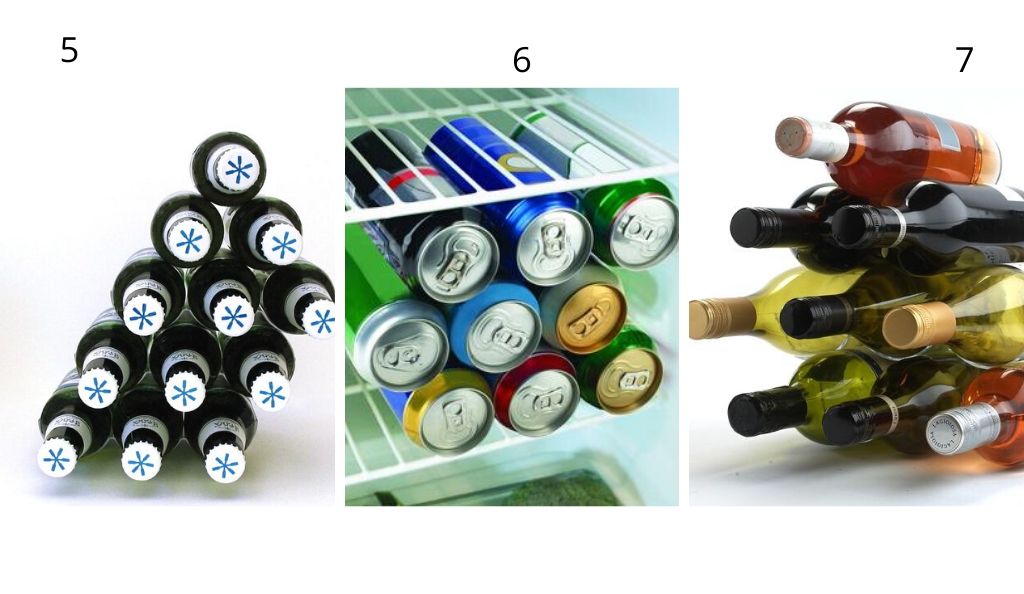
5. Pack of Three Beer Bottle Racks, £7.95 – buy here. 6. Pack of Three Beer and Soda Can Racks, £6.55 – buy here. 7. Pack of Two Wine Bottle Racks, £9.55 – buy here.
The gadgets
Filter the air inside your fridge to remove bad odours and bacteria. The Wpro PurifAir attachment is a small and unobtrusive gadget that fits any fridge and ensures you don't get a waft of last night's dinner every time you open the door. Triple the life of fresh herbs and green vegetables with these BPA-free plastic pods, which allows you to keep them sealed and topped up with water.
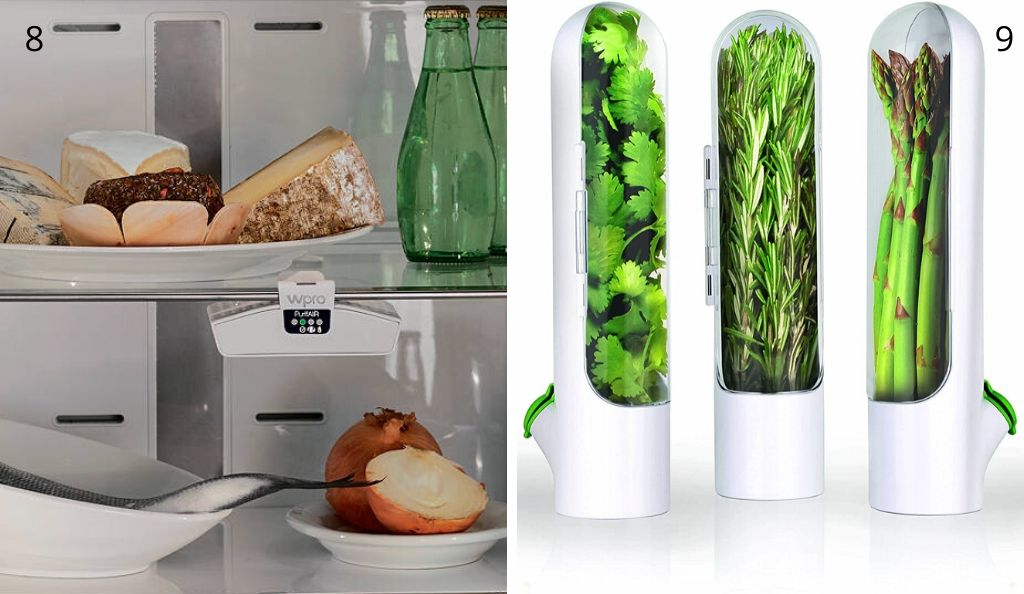
8. Fridge PurifAir Starter Kit, £19.99 – buy here. 9. Herb Savor Pods single £16.76, pack of three, £42.22 – buy here.
You don't need to drop four figures on a smart fridge to let innovative tech take over the admin of food shopping and fridge stocking. Smarter's FridgeCam is the first wireless camera to fit in any fridge. It syncs up with the Smarter app to log expiry dates and take pictures of your fridge so you can keep track of what you have – even when you are out. You can then connect to Siri and Alexa to automate shopping lists and ensure you buy what you need, when you need it, without any lists or mental tallies.

10. Smarter FridgeCam, was £99, now £49 – buy here.
The inspiration
Chefs' Fridges: More Than 35 World-Renowned Cooks Reveal What They Eat at Home
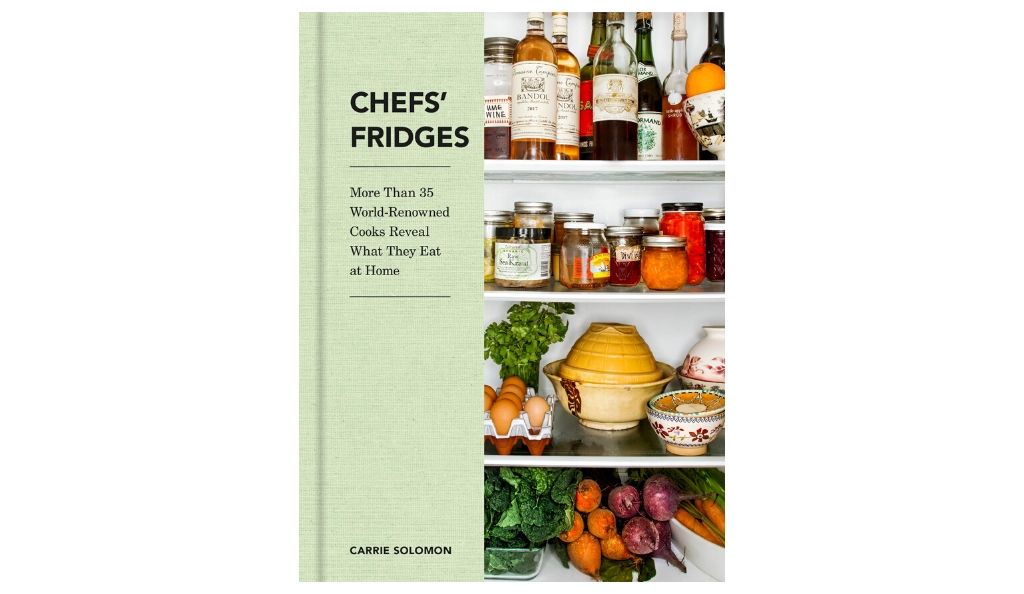
While restaurants closed, we are upping our home cookery credentials and embracing chef techniques – from whisking up a hollandaise to growing a sourdough starter. This fascinating and artfully shot book gives an insight into the way renowned chefs approach food both philosophically and practically, through the contents of their fridges. Full-page annotated photoshoots show us the ingredients these master chefs actually use in daily life, with annotations, interviews, personal essays and recipes lending colour and detail to each fridge. Prepare to get serious condiment envy and to find inspiration from the jars of flavour boosters that take dishes from passable to professional.
Chefs' Fridges is published on 11 June. Click here to pre-order.
Perhaps it's lockdown boredom, heightened germ paranoia or the incessant stress snacking, but focus has shifted onto the refrigerator. Instagram's burgeoning trend for #fridgegoals and #fridgeporn is a rainbow of bright, aspirational images proving that organised fridges are the height of cool. Certainly if you spend as much time as we do with our heads in the fridge, pondering the next nibble, it makes sense to create a pleasant space.
But the appeal of an inviting fridge goes well beyond aesthetics. Re-thinking your food storage system helps you eat sustainably by making produce last longer and reducing reliance on plastic packaging. And showcasing bright, healthy produce will shape your eating habits for the better, by making you more inclined to graze on fresh ingredients or prepare something from scratch instead of reaching for a bag of Kettle Chips.
The deep clean
Start from scratch and use this as opportunity to audit the forgotten jars lurking on the top shelf and target those sticky stains.
1. Take everything out of the fridge. Check expiration dates and inspect jams and sauces for the first fuzz of mould. Throw away anything that is past its best.
2. Fill the sink with warm water and two tablespoons of baking soda; food can absorb odours so avoid any scented or chemical cleaners inside the fridge. Wipe down sticky jars, bottles or pots that will be going back into the fridge. Set aside to fully dry.
3. Now that the fridge is empty, take out the salad drawers and any removable shelves. Soak and wash in the baking soda and water then leave to dry.
4. Use a damp cloth to wipe around the inside of the empty fridge and pat down with kitchen paper or dry cloth to ensure the interior is dry. Use an old toothbrush to scrub corners and hard-to-reach bits.
5. Wipe down the outside door and handle with soapy water or an antibacterial spray, before returning food to the fridge using the organisation method below.
The organisation

Do you keep condiments in the fridge? Should butter be in a dish in the pantry or wrapped in a chilled fridge? What about chocolate – cold or room temperature? While there are plenty of personal preferences that play into your fridge organisation system, these are the general rules to optimise food safety and preservation.
Avoid overfilling your fridge: not only does it increase the likelihood of having to throw food away before you have a chance to eat it, but it can also interfere with the air circulation and alter the temperature equilibrium. As you use things and put them back, try to keep produce that needs eating soonest towards the front of the fridge to reduce waste.
Inside door
This is the warmest part of the fridge and the most prone to temperature fluctuations when you open the door, so keep longer-life items such as jams, spreads, juices and sauces here.
Upper shelves
This is where to store foods that do not need cooking, such as leftovers, cured meats and ready meals.
Middle shelves
The constant temparature makes this the best place to keep all dairy items, from milk and yoghurt to cheese and butter.
Bottom shelf
This is the coldest part of the fridge so the best place for storing raw meat and fish. It also reduces the risk of juices dripping down and contaminating other items.
Drawers
The drawers are more humid, so ideal for keeping fruit, vegetables, herbs and salad fresh.
The storage
Airtight glass containers are the gold standard of the organised fridge. While BPA chemicals in plastic can contaminate food, glass is totally safe. Microwave-ready and easy to clean, it seals in freshness and prevents odours. Plus, being able to see the contents saves time rummaging around and prevents forgotten leftovers from mouldering away under foil.
Group items logically – with a container of cheeses, one of different dips, one for leftovers. Where possible, remove and recycle packaging, then wash any fruit or vegetables before storing so everything is ready to eat and free of any germs or pesticides.

1. Medium Glass Storage Box, £14 – buy here. 2. Teak Stacking Storage Jar, £25 – buy here.
Avoid single-use clingfilm and foil and keep things fresh with more sustainable options. These patterned beeswax wraps provide a watertight seal and a gorgeous pop of colour. Reusable mesh bags are a great way to keep loose vegetables together and bring some order to the bottom drawer of the fridge. Take the bags with you to the greengrocer or supermarket to avoid plastic bags, then transfer straight to the fridge.

3. Three Large Sustainable Beeswax Food Wraps, £26 – buy here. 4. Organic Cotton Food Bag, £8 – buy here.
Those of you not lucky enough to have a dedicated wine fridge will be familiar with the Tetris-like attempts of stacking bottles into a fridge and the inevitable frustration when they roll around and squash nearby food. Maximise space with these ingenious and almost invisible stacking systems, allowing you to double- or triple-stack.

5. Pack of Three Beer Bottle Racks, £7.95 – buy here. 6. Pack of Three Beer and Soda Can Racks, £6.55 – buy here. 7. Pack of Two Wine Bottle Racks, £9.55 – buy here.
The gadgets
Filter the air inside your fridge to remove bad odours and bacteria. The Wpro PurifAir attachment is a small and unobtrusive gadget that fits any fridge and ensures you don't get a waft of last night's dinner every time you open the door. Triple the life of fresh herbs and green vegetables with these BPA-free plastic pods, which allows you to keep them sealed and topped up with water.

8. Fridge PurifAir Starter Kit, £19.99 – buy here. 9. Herb Savor Pods single £16.76, pack of three, £42.22 – buy here.
You don't need to drop four figures on a smart fridge to let innovative tech take over the admin of food shopping and fridge stocking. Smarter's FridgeCam is the first wireless camera to fit in any fridge. It syncs up with the Smarter app to log expiry dates and take pictures of your fridge so you can keep track of what you have – even when you are out. You can then connect to Siri and Alexa to automate shopping lists and ensure you buy what you need, when you need it, without any lists or mental tallies.

10. Smarter FridgeCam, was £99, now £49 – buy here.
The inspiration
Chefs' Fridges: More Than 35 World-Renowned Cooks Reveal What They Eat at Home

While restaurants closed, we are upping our home cookery credentials and embracing chef techniques – from whisking up a hollandaise to growing a sourdough starter. This fascinating and artfully shot book gives an insight into the way renowned chefs approach food both philosophically and practically, through the contents of their fridges. Full-page annotated photoshoots show us the ingredients these master chefs actually use in daily life, with annotations, interviews, personal essays and recipes lending colour and detail to each fridge. Prepare to get serious condiment envy and to find inspiration from the jars of flavour boosters that take dishes from passable to professional.
Chefs' Fridges is published on 11 June. Click here to pre-order.
TRY CULTURE WHISPER
Receive free tickets & insider tips to unlock the best of London — direct to your inbox